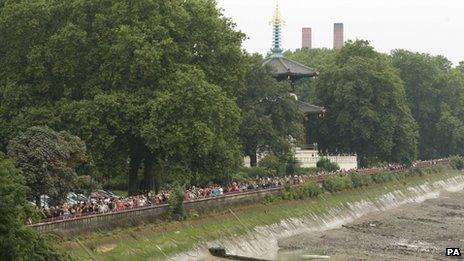In 2013 the iconic London landmark, the Battersea Power Station, was finally about to begin redevelopment after decades of abandonment. The city held an open house event on the weekend of 21-22 September - for free - and forty thousand people passed through the massive mid-century icon over two days. wonder | wander | women were fortunate to be among those people!
The Art Deco-style power station was designed by architects J. Theo Halliday and Giles Gilbert Scott, and chief engineer Leonard Pearce, for the London Power Company.
Construction began on Building A in 1929 and Building B was built between 1937-41. Building was halted during the war years, so the station was only completed in 1955.
 |
| Queues travelling around the Turbine Hall, showing the structure and size of the station |
The power station closed in 1980 but was listed as a Grade II heritage site, protecting it from being demolished. Too enormous to support redevelopment without an equally massive investment, the building remained empty for decades more.
Over the years the station provided an atmospheric backdrop for several British film and TV productions, including Alfred Hitchcock's Sabotage, the BBC's Dr. Who and Neverwhere, Monty Python's The Meaning of Life, and most recently Christopher Nolan's The Dark Knight.
 |
| Still from The Dark Knight (2007), one of the many films set at the station. |
Of course, since there were forty thousand of us who came to see it, the queue was unprecedented, stretching all the way to the giant pagoda at nearby Battersea Park!
 |
| From bbc.co.uk |
I'd only been to the area a few times, so there were lots of sights to keep me occupied before the main event: the pagoda, boat races along the Thames, or the enormous cranes in front of the station, which were built to unload coal from barges coming down the river and are also Grade II historical structures.
When we finally got in there were hordes of people filling the designated public areas, which had been cordoned off to protect us from wandering into the deteriorated, unsafe sections of the building.
We admired a scale model of the building as it had been in use, with coal and gas generating the power. The new building will also include an Energy Centre - providing green energy for the building instead, and hopefully for surrounding neighbourhoods in the future.
We wandered around the building, sticking to the carefully chosen safety ramps, a snaking crawl of mindlessly snapping photographers. Who knew when we would ever see the inside of this place again?
I was only sad not to see the resident peregrine falcons, but they were - and are - alive and well and thriving in the new space. Several bird species live and forage in the area and we were glad to know that the redevelopment companies were encouraging wildlife to remain by creating new feeding spaces.
| Photo by Dave Morrison at Battersea Power Station |











No comments:
Post a Comment
Note: Only a member of this blog may post a comment.